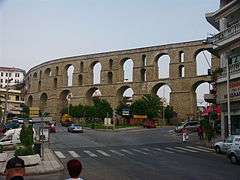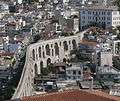Aqueduct of Kavala
The Aqueduct of Kavala, popularly known as the Kamares (Greek: Καμάρες, "arches"), is a well-preserved aqueduct in the city of Kavala, Greece, and is one of the city's landmarks.

While the aqueduct is of Roman origin, the present structure built by the Ottomans in the 16th century.[1] A Byzantine barrier wall of the early 14th century, built as part of the fortifications on the Acropolis of Kavala, probably also functioned as an aqueduct. If so, it would have been a rare example of a Byzantine aqueduct, since Byzantine cities more typically used wells and cisterns rather than either maintaining existing Roman aqueducts or building new ones.[2] The barrier wall was replaced with the present arched aqueduct during Suleiman the Magnificent's repair and improvement of the Byzantine fortifications. Some authors date that construction to the time of the 1522 Siege of Rhodes, but a more likely date is between 1530 and 1536.[3] As late as 1911, it was still being used to supply the city with drinking water from Mount Pangaeus.[4]
Gallery
References
- Jack Finegan (1981). The Archeology of the New Testament: The Mediterranean World of the Early Christian Apostles. Taylor & Francis. p. 100. ISBN 0-7099-1006-1.
- Charalambos Bakirtzis (2008). "Secular and military buildings". In E. Jeffreys; J. Haldon; R. Cormack (eds.). The Oxford Handbook of Byzantine Studies. Oxford University Press. pp. 380–381. ISBN 0-19-925246-7.
- Machiel Kiel (1996). "Ottoman building activity along the Via Egnatia: The cases of Pazargah, Kavala and Ferecik". In Elizabeth Zachariadou (ed.). The Via Egnatia Under Ottoman Rule (1380-1699). Crete University Press. p. 151. ISBN 960-524-017-3.
- "Kavala". Encyclopædia Britannica (11th ed.). 1911. p. 701.
| Wikimedia Commons has media related to Kavala aqueduct. |



.jpg)


